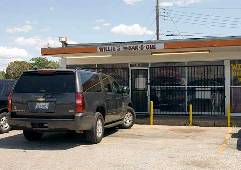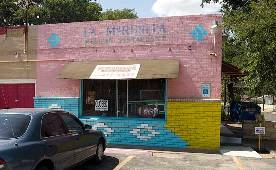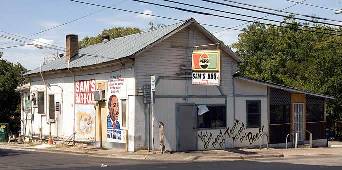|
HEB's Operation Meat Locker
Helps law enforcement bust ORC Ring selling stolen meat to 3 restaurants
Take care the next time you order high-quality meat at a lower-than-possible
price. With food prices escalating, meat thieves – organized groups who target
steaks and high-end cuts at supermarkets for resale to unscrupulous restaurants
and markets – are a growing problem. They're also hitting meat lockers, cattle
pens and 18-wheelers.
 The
most recent example was in Austin, where in late July police arrested six men in
what they dubbed Operation Meat Locker. The sting operation started when
managers at H-E-B, a Texas supermarket chain, called police to say that they had
stopped a couple of shoplifters who said they were selling the meat they stole
to three local restaurants. The
most recent example was in Austin, where in late July police arrested six men in
what they dubbed Operation Meat Locker. The sting operation started when
managers at H-E-B, a Texas supermarket chain, called police to say that they had
stopped a couple of shoplifters who said they were selling the meat they stole
to three local restaurants.
H-E-B was mostly worried about the safety of the consumers who were ending up
eating the meat. "They're watching these guys with this stuff in their pants,
and besides being nasty, what's the temperature of the meat?" says Sgt. David
Socha, who took part in the investigation.
To stop it, officers took fresh meat to more than 28 area restaurants to offer
for sale. It wasn't an easy sting to carry
out because unlike
the thieves, they had to abide by food safety
regulations. "The meat had to be kept under 41 degrees,
so we didn't have much time to work," Socha says.
None of the 25
restaurants chosen at random would touch the meat
brought to their back doors and offered at half off, but
the three who'd been fingered by the shoplifters "bought
it again and again and again," Socha says. It wasn't
just staff looking to make money on the side, but
management who were involved, "so we knew it wasn't a
fluke," he says.
After each
restaurant had bought more than $1,500 worth of stolen
meat, making it a felony, police moved in and made
arrests July 28.

This sort of
organized retail crime is a common and growing problem,
says Joseph LaRocca, who focuses on asset protection for
the
National Retail Federation. A recent poll by the
group found 95% of retailers falling victim to it in
2010, up from 89% in 2009. According to LaRocca, more
than two-thirds of members say "these groups are getting
more brazen and they're getting hit harder."
High-ticket consumable goods that are easily resold "are the most commonly
ripped off" and meat falls into that category,
along with infant formula, razors and over-the-counter
drugs, LaRocca says. Although it doesn't track meat
thefts specifically, the federation says annual losses
from such organized groups can reach as high as $30
billion.
Organized
retail crime rings consist of professional shoplifters, called boosters, who
take "orders" from fences who buy the
pilfered product. "Their entire job is to go out and
steal. It seems that they stay within their realm: Meat
thieves will steal meat," says Scott Stanley, an officer
with the Tacoma, Wash., Police Department. Stanley is
also the founder of the Washington State Organized
Retail Crime Alliance.
In his experience, most of the boosters are drug addicts. Many are even paid in
drugs. "They say 'You go out and steal me $150
in tri-tip (roasts), and I'll give you enough crack for
a week," he says.
 The meat gets sold
to unscrupulous restaurants or out of the back of a van
at swap meets. Sometimes it goes to mom-and-pop
convenience stores. "We've gone into a Shell (gas)
station and found steaks with the Safeway sticker still
on them," Stanley says. The meat gets sold
to unscrupulous restaurants or out of the back of a van
at swap meets. Sometimes it goes to mom-and-pop
convenience stores. "We've gone into a Shell (gas)
station and found steaks with the Safeway sticker still
on them," Stanley says. Supermarkets have
long been aware of the problem, says Jason Moulton,
Safeway's Seattle District loss prevention director.
"They'll steal shrimp and lobster and high-value cuts of
meat," he says. His job has been made somewhat easier
recently by new laws smoothing the way for prosecution
of organized retail theft. There's also a movement
within the grocery world to work together to fight the
thieves. "We don't compete in this area," he says. "We
share information with other grocers so we get to these
guys quicker."
Not only are the meat cuts stolen goods, but they're potentially a source of
sickness. These meats aren't being refrigerated. A
common way for thieves to grab the meat is to shove it
down their pants. "They'll rubber-band the bottom of
their sweats at the ankle and then they just start
shoving it down their pants and they load up their pants
leg," Stanley says.
"The lack of
refrigeration is a serious food safety concern; so is
the suspect handling," says Douglas Powell, a professor
of food safety at Kansas State University in Manhattan,
Kan. "And if restaurant owners are willing to cut
corners and buy street meat, what else are they cutting
corners on in the back kitchen? It doesn't inspire
confidence."
The organizations
aren't all small-scale. Thieves made off with $11,000
worth of meat from Sedlacek's Wholesale Meat Co. in
Melbourne, Iowa, in February. Owner Barry Sedlacek came
in one morning to find his cooler door open and 2,500
pounds of top-quality meat missing.
Though he had
security, Sedlacek says, he has come to realize how much
meat is a target. "Now we've got cameras on, we've got
new locks, steel mesh over the windows. People go by and
they say it looks like Fort Knox," he says.
Texas has had
between 700 and 800 cattle rustling cases this year,
says
Larry Gray, law enforcement officer for the Texas
and Southwestern Cattle Raisers Association in Fort
Worth. "There's been an uptick in cattle thefts, first
because of the economy and also because cattle prices
are so high," he says.
An 800-pound steer is worth about $880 right now, he says. Thieves will pull up
to a feeding pen, load up their truck and "be
out of there in 10, 15 minutes," Gray says. They sell
them at livestock auctions for quick cash.
The thieves aren't
novices when it comes to cattle, Gray says. They're
people who have worked in the industry and know how to
load and market big, dangerous animals. "We don't find
many city boys who decided to steal some cattle."
The market is big.
Sometimes it's 41,350 pounds of ground beef out of an
18-wheeler. That's what police in Geneva, Ala.,
discovered when they checked out an empty
tractor-trailer parked in town on Feb. 1 and traced it
to a $95,000 load of ground beef that had been stolen
from a Louisiana truck stop.
"The driver parked
it, and when he got back, it was gone," says Lt. Rickey
Morgan of the Geneva police. Meat inspected by
USDA is shipped with a special locking tag on the
back of the truck, Morgan says. "You'll have folks that
ride around truck stops, they'll see the tag and they
know it's some type of meat product. It may be
hamburger, it may be steaks, they don't know, but they
know it's a high-dollar load," he says.
Geneva police traced
"eight or nine pallets" containing 20-pound packages of
ground meat to a local store that sells discount foods,
"a bent-can store" as Morgan describes it. Each package
had a serial number and the insurer had photographs of
all of them, so they were able to identify the meat. It
was recovered and then destroyed because it was
impossible to know whether it had been contaminated
during its sojourn.
Report Your ORC News & Educate The Industry
Your News May Help Create New Jobs!
|

 The
most recent example was in Austin, where in late July police arrested six men in
what they dubbed Operation Meat Locker. The sting operation started when
managers at H-E-B, a Texas supermarket chain, called police to say that they had
stopped a couple of shoplifters who said they were selling the meat they stole
to three local restaurants.
The
most recent example was in Austin, where in late July police arrested six men in
what they dubbed Operation Meat Locker. The sting operation started when
managers at H-E-B, a Texas supermarket chain, called police to say that they had
stopped a couple of shoplifters who said they were selling the meat they stole
to three local restaurants.
 The meat gets sold
to unscrupulous restaurants or out of the back of a van
at swap meets. Sometimes it goes to mom-and-pop
convenience stores. "We've gone into a Shell (gas)
station and found steaks with the Safeway sticker still
on them," Stanley says.
The meat gets sold
to unscrupulous restaurants or out of the back of a van
at swap meets. Sometimes it goes to mom-and-pop
convenience stores. "We've gone into a Shell (gas)
station and found steaks with the Safeway sticker still
on them," Stanley says.
